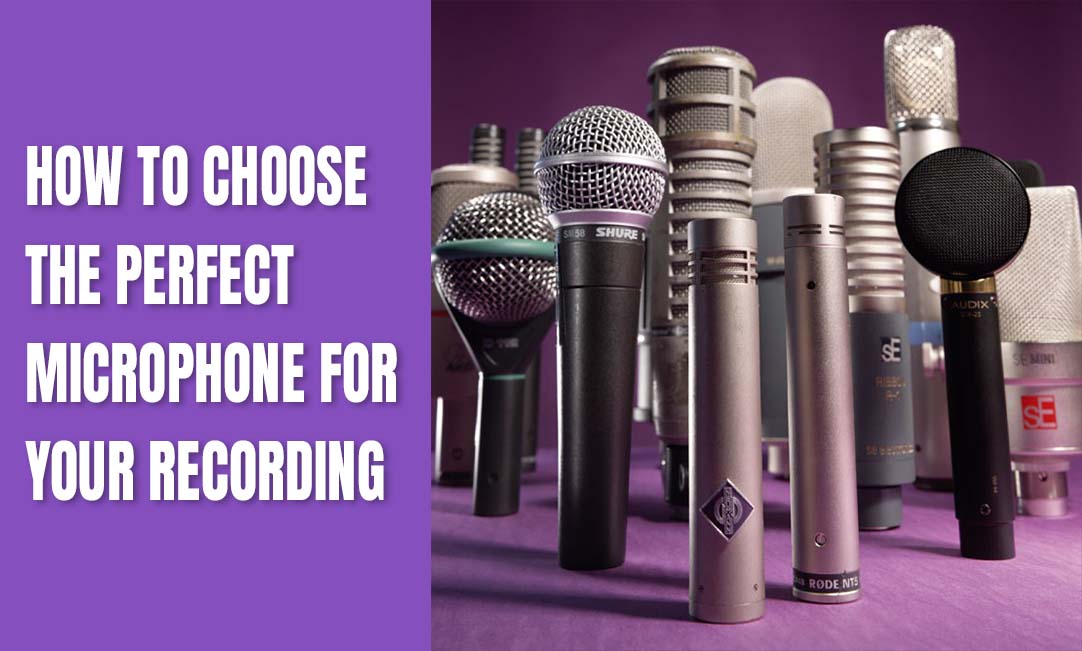How to Choose the Perfect Microphone for Your Recording

11-Sept-2023
As you enter the world of sound recording, you will understand the importance of a microphone. Choosing an appropriate microphone will be one of the most crucial decisions. Whether you're a music artist, podcaster, voice actor, or content creator, the microphone will impact the sound quality of your recordings. You can find a number of options in the market, but choosing the right one that caters to your needs can be challenging. This guide aims to make the process easier and assist you in selecting the ideal microphone in a recording studio.
- Understand Your Recording Purpose
Determine your recording goal before delving into the technical details of microphones. Are you making recordings of podcasts, interviews, music, podcasts, or videos? You can capture the best sound quality with a microphone for a given application. For example, a dynamic microphone might be better suited for live sound or louder environments than a condenser microphone for recording vocals.
- Know the Types of Microphones
There are three main types of microphones – Dynamic, condenser, and ribbon microphones. Understand your needs and choose one among these at recording studios.
1. Dynamic Microphone
Dynamic microphones are a good choice for recording loud sound sources like guitars and drums. They are durable and multipurpose. They are appropriate for live performances and can handle loud sound pressure levels.
Some examples of dynamic microphones are Shure SM57, Electro-Voice RE20, Sennheiser MD-441 U, Royer R-121, AEA R84, and others.
2. Condenser Microphones
These are better for recording vocals, acoustic instruments, and fine details because they are more sensitive and can capture a wide frequency range. It comes in two types - Large-diaphragm (for vocal) and small-diaphragm (for equipment).
Some examples of condenser microphones are Rode HF6, AKG CK12, Neumann K67, Neumann KK84, and others.
3. Ribbon Microphones
Although delicate, these have a classic, warm sound. They are frequently employed within recording studios to record particular instruments or to create a specific sonic character.
Examples of ribbon microphones are Royer R-121, Coles 4038, Beyerdynamic M 160, AEA R88, Royer R-122, and others.
- Learn about the Polar Patterns
A crucial aspect of a microphone is its polar pattern. It determines how microphones capture sounds in a recording studio from different directions. Common polar patterns are
a. Cardioid: It minimizes sound from the sides and back while capturing sound primarily from the front. Ideal for removing background noise and focusing on the sound source. Generally, you can use it to record solo vocals.
b. Omnidirectional: It picks up sound from all directions. Suited for recording a background or natural sound. It is a preferred choice during group recording.
c. Figure-8 (Bidirectional): Rejects sound from the sides while capturing sound from the front and back. It is helpful in recording two sources coming from opposite directions. An ideal choice for recording interviews.
- Budget Considerations
Prices for microphones can vary widely. Setting a budget and prioritizing quality microphones should be done based on your needs. While high-end microphones can produce sound of exceptional quality, there are also more affordable options that deliver excellent value for the money in recording studios.
- Compatibility and Connectivity
Think about the connectivity options the microphone provides. Those who are just starting out or prefer a plug-and-play setup can use USB microphones. On the other hand, XLR microphones give better audio quality and are preferred in professional recording studios. Ensure the microphone you want has the essentials like cables, pop filters, and shock mounts. You must also look if your microphone is compatible with your computer, audio interface, or mixer.
- Room Acoustics and Noise
The choice of microphone greatly depends on the environment in which you're recording. You might have more flexibility if you're in a specially designed studio environment. Microphones with good off-axis rejection, such as cardioid patterns, can reduce unwanted background noise and reflections in less controlled environments.
- Test and Compare
Before choosing one, try out a few different microphones if at all possible. Trust your ears; the sound of a microphone can be subjective. You can try out microphones at music stores or recording studios.
-
Read Reviews and Seek Recommendations
Read user reviews and ask other music artists, podcasters, or content producers who have similar recording requirements for advice. Their experiences may offer insightful information about how various microphones perform.
Conclusion
A great recording is the result of several factors, including the caliber of the performance, the setting in a professional recording studio, and the choice and use of the microphone. Although we've provided some guidelines, the "right" mic for the job is a matter of personal choice. You'll be nailing perfect takes in no time if you learn what your microphones bring to each recording scenario, and remember, don't be afraid to experiment.